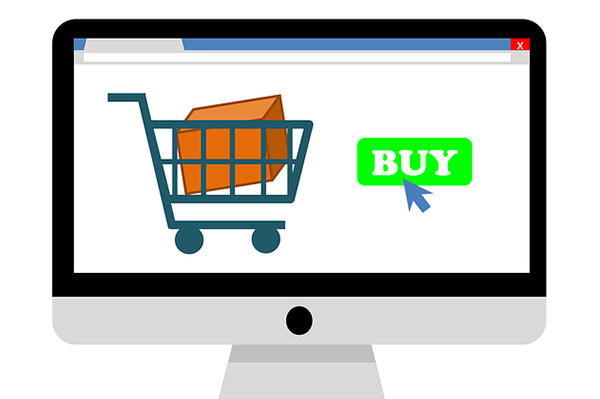Online shopping websites help you buy products from your favorite brands in less time. Retail stores recognizing such benefits are finding the digital market more delightful than there conventional brick and mortar place. Hence, they are fast shifting their place online; to sell their stuff on the web and definitely, a simple shopping website would suffice for such purpose.
You would be surprised to know that 217.1 million people in the U.S are online shoppers, and it is estimated that by 2019 the numbers would rise to 224 million. (Statista.com 2017)
If you are gearing up to be a part of that number, you can start with a simple shopping website. Today there are a lot of good options available to build a shopping website, but when it comes to actually get the ball rolling there will be a lot of confusion.
The purpose of this blog is to help you clear off such doubts. It doesn’t matter whether you are developing a simple site or complex one because you will definitely face certain challenges. But no matter what, your purpose should be to create a website that would make the process simple and intuitive for the customers.
Steps to build a Simple Shopping Website
STEP I: Choose a Domain
Your very first task towards building a successful website is choosing a domain name.
Domain names are important because they provide you a prominent place in cyberspace. In simple words, if you want to understand the meaning of a domain name, then it is your website’s address. Virtually, you are giving your brand an address in the online space.
Now comes the tricky part. You are a high-on-energy entrepreneur, a newbie, know that you have to have a domain name for your website, but on the same, you should be smart while choosing one.
Because a domain name can impact SEO.
Related: Domain Name and its Impact on SEO
When I say impact, it can be constructively or the other way round. Refer the above blog to know how. But a word of advice for you, never pick a exact match domain (EMD).
Here are few tips you should follow if are choosing a domain name.
- I know it’s difficult, but always stick with ‘.com’ extension, because it is the most the popular. You can find a lot of newer extensions, but people are yet to trust them, so play safe.
- Use keywords, don’t stuff, but be creative and make a domain name inclusive of keywords. The only purpose is people will find it easier to connect and not to forget, you will rank higher in Google.
- You are not playing tongue twister game, so keep your domain name short, simple, memorable, and easy to pronounce.
- No hyphens, because it can be a sign of spam domain. Also, make sure to keep the name unique and brandable.
STEP II: Pick the Right Platform
You have a lot of e-commerce platforms to choose, free, premium, but your task is to choose the right one.
The platform you choose should help your business. You have to choose the right foundation for your business. WordPress, Drupal, Weebly, Joomla, Squarespace, Magento, Shopify, and etc are some of the commonly used website platforms,
In terms of plugins, templates or other features, each of these platforms differs. It’s definitely not ‘one size fits all’, and picking the wrong platform will only do bad for your business, so do it right.
Ask yourself these questions if you are finding it challenging to pick a right platform.
- How big is the stock size?
- What are the features and functionalities that you prefer to have on your website?
- Self-hosting or Third-Party Hosting, do you need code-level access to your website?
- Templates, SEO, Plugins, how good should be the customization features?
- Do you prefer your website to support 3rd party payment processors?
STEP III: Design Your Online Store
A simple shopping website, the words don’t guide you to be ignorant about the way you design your website.
When you choose a right platform, you get to choose from a lot of themes and templates. Select one that gives your brand a good upfront. The logo should be prominent and trustmarks must be present to make customers trust your brand.
Also, add high-quality images, videos, anything that would uplift the appearance of your website. The content included should be unique. Consistency is a must for visual hierarchy, so navigating through the website will be effortless for your customers.
STEP IV: Set Up Payment Gateway
First, let’s understand about payment gateway.
‘It’s a software service that supports real-time transaction between an online store and a customer.’ Security is one of the core elements of every payment gateway.
The feature is easy to setup and allows customers to conveniently make payments from anywhere through their credit or debit cards.
Luckily, you have a good number of options to choose from, integrated or hosted, modern or classic, so you can start narrowing down the options by comparing the prices, according to your convenience.
STEP V: Start Adding Products
Once you create a website, you should start adding products.
- Start with the product type (physical, digital, or service).
- Include high-quality product photos or videos, it improves conversion rates.
- Set the price and quantities available for products on sale.
- Create product description that is SEO-friendly.
- Specify any variants if available and the pricing options.
STEP VI: Create a Simple Checkout Funnel
Even some of the greatest brands have suffered this, cart abandonment. Why? Because customers found their checkout funnel too complex and time-consuming.
So, create a checkout funnel that converts. Look down at these points to understand how you should be designing one.
- Acknowledge every small action of the user via some visual cue.
(Small animation/confirmation text to say a product has been added to the cart)
- The cart contents should be visible and flexible for customers to make changes.
- The navigation should be intuitive. (Maintain good visual hierarchy).
- Encourage them to proceed further with messages like pay securely, free shipping, and easy returns.
- Use remarketing campaigns, send emails to people who abandoned the cart and get them to convert.
Step VII: Don’t Forget about SEO & Analytics
If a website is an engine, SEO is the fuel.
You cannot successfully run an online business without SEO. You have to optimize your website for search engines to make it prominently visible on the search engine result page (SERP).
Follow the latest SEO guidelines and improve your online presence. On-page and off-page optimization, get it right, ultimately people do research on products they buy, and you have to stay on top if you want some business.
Once you are through with SEO campaign, use Google Analytics tool to monitor and track the performance of your shopping website. With the data available optimize your marketing efforts and improve your performance for better reach and conversions.
Call Adroitte
Contact us to discuss your NGO related website design requirement. Call us today on +917760487777 or 08041127377 or message us on our contact form and we will reply back ASAP. We can discuss how we can strategically implement NGO website design successfully for your organization.




